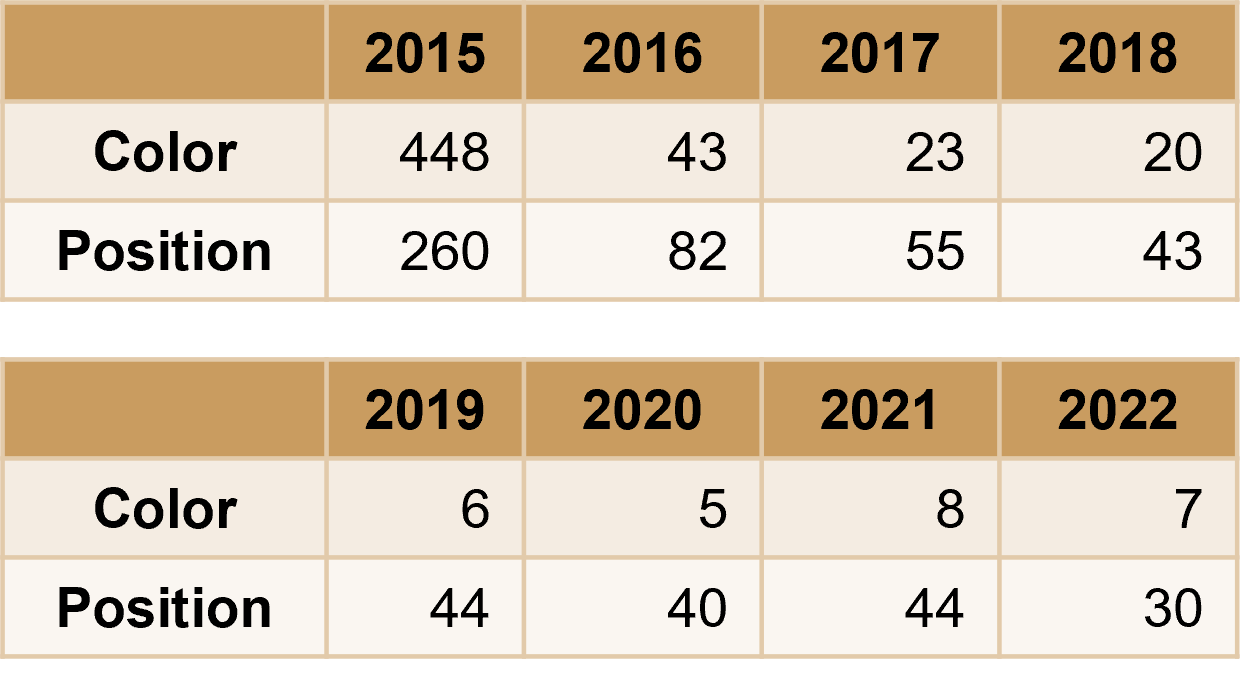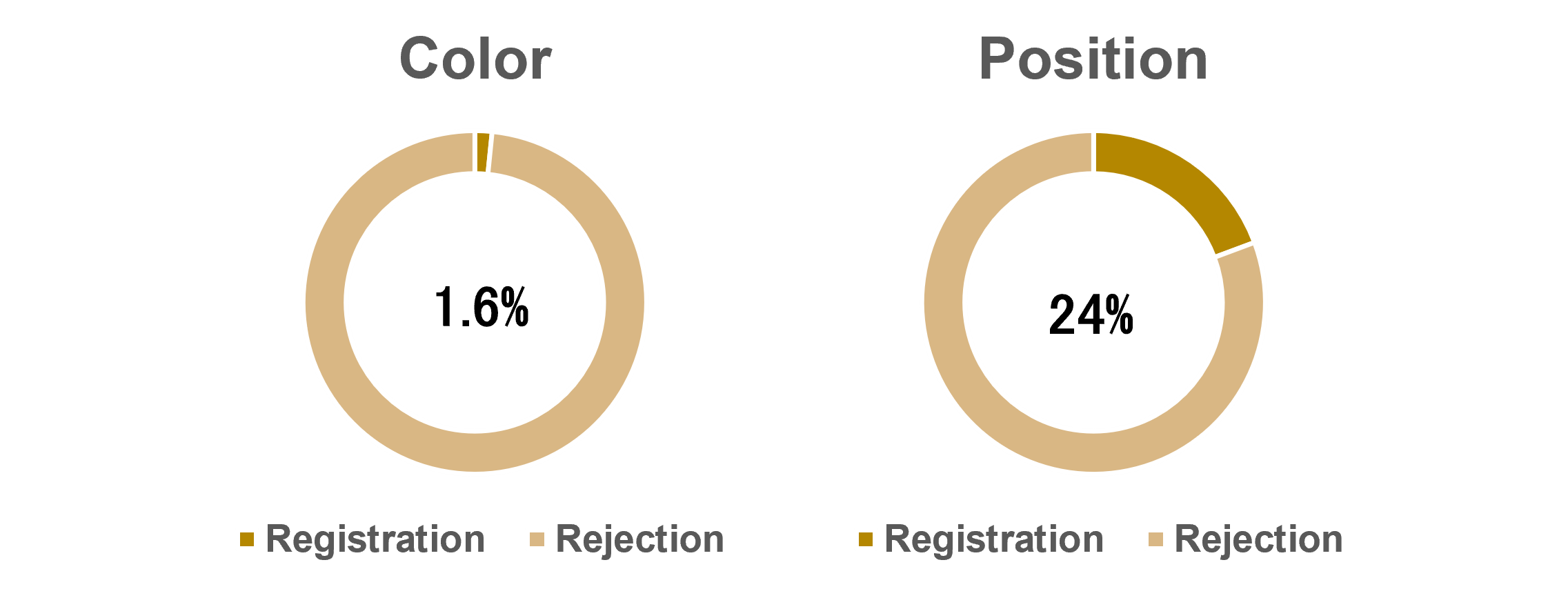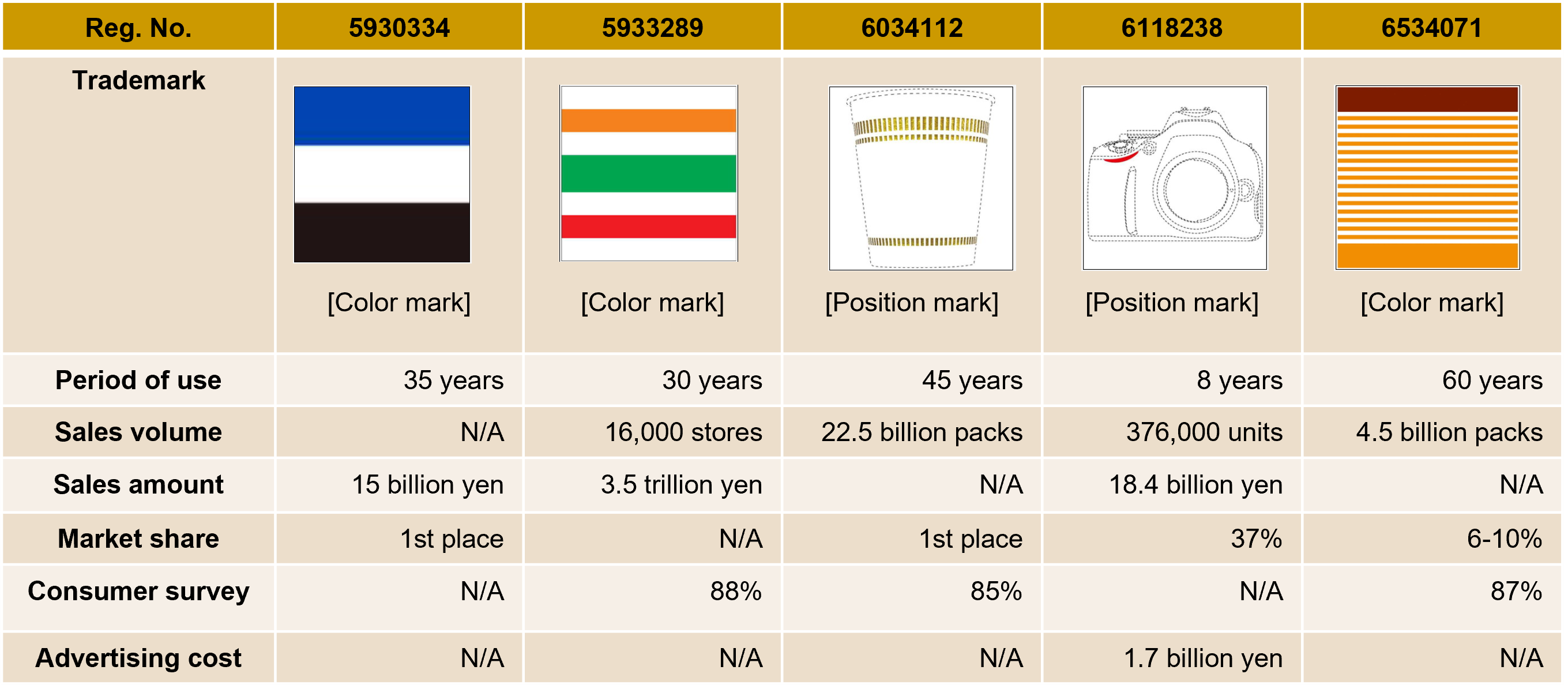ブログ
Looking Back on the First 10 Years of “Color Trademarks” and “Position Trademarks” in Japan -Part 1-
2025.03.11
Introduction
The 2014 amendment to the Japanese Trademark Law has made it possible to register Non-Traditional Marks (“NTMs”) that were previously unprotected, such as “color trademarks” and “position trademarks.” Now, 10 years have passed since the introduction of the NTMs and examinations and court cases are gradually accumulating. In this article, I will review the statistical information and the actual registrations of “color trademarks” and “position trademarks” during these first 10 years.
Statistical information on “Color Trademarks” and “Position Trademarks”
Number of applications
In 2015, when the NTMs started, a considerable number of applications were filed. According to the “Trademark Application Trend Survey 2019”[1] and “Trademark Application Trend Survey 2023” [2] by the JPO, the filing number of “color trademarks” was 448 and the filing number of “position trademarks” was 260 in 2015. After the first rush of applications ended, the number of applications has somewhat stabilized. Recently, however, the number of applications has decreased considerably. According to the JPO’s survey, the filing number of “color trademarks” was 7 and the filing number of “position trademarks” was 30 in 2022.

The statistical information indicates that the “color trademarks” and “position trademarks” are not being used very actively.
Registration rate
The registration rate for “color trademarks” and “position trademarks” is quite low. The rate for “color trademarks” is 1.6% and the rate for “position trademarks” is 24%. Of these, no registration for “trademarks consisting solely of a single color” has been approved in the last 10 years. [3]

Reasons for refusal
The main reason for refusal of “color trademarks” and “position trademarks” is lack of distinctiveness. Around 500 “color trademarks” have been refused due to lack of distinctiveness and more than 350 “position trademarks” have been refused due to lack of distinctiveness as indicated in the below chart.

Please note that there may be multiple reasons for rejection for a single application.
Registrations of “Color Trademarks” and “Position Trademarks”
The above statistical information indicates that the hurdle for registering “color trademarks” and “position trademarks” is extremely high. However, in some cases, the applicants were able to successfully prove the secondary meaning of their marks in response to the Refusal due to lack of distinctiveness and lead their marks to registration.
For Reg. No. 5930334, TOMBOW PENCIL CO., LTD. (“TOMBOW”) filed a trademark application for the color combination of their erasers designating erasers in Class 16 on April 1, 2015. In response to the Office Action due to lack of distinctiveness, TOMBOW argued secondary meaning and submitted evidential materials including the period of use (more than 35 years), sales amount (more than 15 billion yen) and market share (1st place). The JPO eventually admitted the secondary meaning and the mark was registered on March 10, 2017.
For Reg. No. 5933289, SEVEN-ELEVEN JAPAN CO., LTD. (“SEVEN-ELEVEN”) filed a trademark application for the color combination of their corporate brand designating various retail services in Class 35 on April 1, 2015. In response to the Office Action due to lack of distinctiveness, SEVEN-ELEVEN argued secondary meaning and submitted evidential materials including the period of use (more than 30 years), number of stores (more than 16000), sales amount (more than 3.5 trillion yen) and consumer surveys (around 88% awareness). The JPO eventually admitted the secondary meaning and the mark was registered on March 17, 2017.
For Reg. No. 6034112, NISSIN FOODS HOLDINGS CO., LTD. (“NISSIN”) filed a trademark application for a “position trademark” for their instant noodle’s packaging designating instant noodles with cup-shaped ingredients and soup, etc. in Class 30 on August 4, 2015. In response to the Office Action due to lack of distinctiveness, NISSIN argued secondary meaning and submitted evidential materials including the period of use (more than 45 years), sales volume (more than 22.5 billion packs), market share (1st place) and consumer surveys (around 85% awareness). The JPO eventually admitted the secondary meaning and the mark was registered on April 6, 2018.
For Reg. No. 6118238, NIKON CORPORATION (“NIKON”) filed a trademark application for the position of their camera designating single-lens digital cameras in Class 9 on April 1, 2015. In response to the Office Action due to lack of distinctiveness, NIKON argued secondary meaning and submitted evidential materials including period of use (more than 8 years), sales volume (more than 376,000 units), sales amount (more than 18.4 billion yen), market share (37%) and advertising cost (around 1.7 billion yen). At the examination stage, the JPO did not admit such argument and issued a Decision of Rejection. Nikon appealed against the Decision and in the trial, the trial board eventually admitted the secondary meaning and the mark was registered on February 1, 2019.
For Reg. No. 6534071, NISSIN FOODS HOLDINGS CO., LTD. (“NISSIN”) filed a trademark application for the color of their instant noodle’s packaging designating instant noodles in Class 30 on July 12, 2018. In response to the Office Action due to lack of distinctiveness, NISSIN argued secondary meaning and submitted evidential materials including the period of use (more than 60 years), sales volume (more than 4.5 billion packs), market share (6-10%) and consumer survey (around 87% awareness). The JPO eventually admitted the secondary meaning and the mark was registered on March 25, 2022.

Conclusion
In recent years, it appears that “color trademarks” and “position trademarks” are not being used very actively - the statistical information indicates that the high hurdles for registration are thought to be one factor for this situation. However, now that 10 years have passed, there are multiple examples of secondary meaning being recognized and registration being granted through appropriate arguments and evidence. Now, we can learn the practical points from actual registrations, especially pointers for proving secondary meaning. In a subsequent issue, I will introduce examples of court cases for “color trademarks” and “position trademarks”.
[1] “Trademark Application Trend Survey 2019”
https://www.jpo.go.jp/resources/report/gidou-houkoku/document/isyou_syouhyou-houkoku/2019shohyo_macro.pdf
[2] “Trademark Application Trend Survey 2023”
https://www.jpo.go.jp/resources/report/gidou-houkoku/document/isyou_syouhyou-houkoku/2023shohyo_macro.pdf
[3] “No Single-Color Marks Registered Yet (Shunji Sato)” https://www.tmi.gr.jp/eyes/newsletter/2020/12063.html
Member
PROFILE

